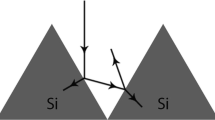Abstract
Higher price-per-watt of silicon (Si) solar cells is still the main bottleneck in their widespread use for power generation due to their expensive manufacturing process. The n-type zinc oxide (n-ZnO) and p-type Si (p-Si) based single heterojunction solar cell is one of the several methods being tried to replace conventional Si single homojunction solar cell technology. In this work, we have explored the possibility of producing photovoltaic materials by employing RF sputtering and hydrothermal technologies. Conductivity of ZnO nanorods has been increased by aluminium (Al) doping. The advantages of using Al doped ZnO (AZO) nanorods (NRs) have been investigated. The integrated reflectance (IR) has been found to be only ~2.86%. Hence, the short circuit current density (Jsc) has been increased by minimizing the reflection loss of solar cells. AZO NR array have been developed over several large area (3″ × 3″) textured p-Si wafers to confirm the repeatability. The maximum efficiency of AZO NRs/Si solar cell of 0.8 cm2 area has been found to be 6.25% for textured p-type Si wafer which is much higher than reported hitherto for this type of solar cell. A simple, low temperature, low cost procedure is thus being proposed, which has the potential of attaining lower cost of production of heterojunction silicon solar cells.
Similar content being viewed by others
References
Purica M, Budianu E, Rusu E (2000). Microelectron Eng 51–52:425–431
Mandalapu LJ, Xiu FX, Yang Z, Zhao DT, Liua JL (2006). Appl Phys Lett 88:112108
He JH, Ho CH (2007). Appl Phys Lett 91:233105
Afify HH, EL-Hefnawi SH, Eliwa AY, Abdel-Naby MM, Ahmed NM (2005). Egypt J Solid 28(2):243–254
Yen T, Li M, Chokshi N, DeLeon RL, Kim J, Tompa G, Anderson WA (2006). IEEE 2:1653–1656
Baik DG, Cho SM (1999). Thin Solid Films 354:227–231
Wei-Ying Z, Sheng Z, Li-Jie S, Zhu-Xi F (2008). Chin Phys Lett IOP Science 25:1829–1831
El-Amin AA (2017). Silicon 9:385–393
Ohyama M, Kouzuka H, Yoko T (1997). Thin Solid Films 306:78–85
Carcia PF, McLean RS, Reilly MH, Nunes Jr G (2003). Appl Phys Lett 82:1117–1119
Shokeen P, Jain A, Kapoor A, Gupta V (2016). Plasmonics 11:669–675
Atwater HA, Polman A (2010). Nat Mater 9:205–213
Fan X, Zheng W, Singh DJ (2014). Light Sci Appl 3:e179
Shokeen P, Singh YP, Jain A, Kapoor A (2015). J Nanophotonics 9:093066
Zhang XM, Golberg D, Bando Y, Fukata N (2012). Nanoscale 4:737–741
Pietruszka R, Witkowski BS, Luka G, Wachnicki L, Gieraltowska S, Kopalko K, Zielony E, Bieganski P, Placzek-Popko E, Godlewski M (2014). Beilstein J Nanotechnol 5:173–179
Hussain B (2017) Progress in photovoltaics, vol 25, pp 919–927
Shokeen P, Jain A, Kapoor A (2017). Opt Mater 67:32–37
Das NC, Biswas S, Sokol PE (2011). J Renew Sustain Energy 3:033105
Roy AB, Das S, Kundu A, Banerjee C, Mukherjee N (2017). Phys Chem Chem Phys 19:12838–12844
Lumerical Solutions Inc. Lumerical FDTD solutions. http://www.lumerical.com. Accessed 30 Nov 2016
Ghosh H, Mitra S, Dhar S, Nandi A, Majumdar S, Saha H, Datta SK, Banerjee C (2017). Plasmonics 12:1761–1772
Thornton JA (1974). J Vac Sci Technol 11:666–670
Acknowledgements
This work has been supported by the Ministry of New and Renewable Energy (MNRE) (31/40/2010-11/PVSE), Govt. of India, Department of Science and Technology (DST) (DST/TM/CERI/D09 (G)). The authors are grateful to Prof. A.K. Barua for his enormous support and guidance. The authors are also thankful to Prof. H Saha, Principal Investigator of the project for his encouragement and help.
Author information
Authors and Affiliations
Corresponding author
Additional information
Publisher’s Note
Springer Nature remains neutral with regard to jurisdictional claims in published maps and institutional affiliations.
Rights and permissions
About this article
Cite this article
Sharma, J.R., Das, G., Roy, A.B. et al. Design Analysis of Heterojunction Solar Cells with Aligned AZO Nanorods Embedded in p-type Si wafer. Silicon 12, 305–316 (2020). https://doi.org/10.1007/s12633-019-00134-4
Received:
Accepted:
Published:
Issue Date:
DOI: https://doi.org/10.1007/s12633-019-00134-4




